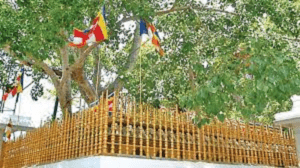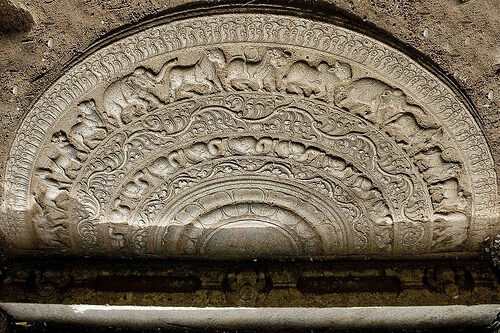A New Chapter In the Civilisation
Since the arrival of the Mauryan delegation and Buddhism, there has been an awakening in Sinhalese literature. The alphabet that had been invented in India was introduced to Sri Lanka. The language became rich. An advanced architecture was developed. Along with various Buddhist rituals, a rich civilisation was born. Many art forms, like sculptures, carvings, etc., took shape, giving rise to a rich culture. People learnt compassion, cultivating wholesome values with the establishment of Buddha Sasana.
The king and the people became devoted Buddhists lifestyles. People’s hobbies turned out to be focused on spiritual activities; hence, culture and the arts exhibited Buddhist influence. Lanka was steered in a spiritual direction from then on.
The Sri Maha Bodhi tree (Ficus religiosa) that Sanghamitta Theri brought to Lanka is still alive in Sri Lanka today, and it is the oldest known tree in the world, being over 2300 years old.
I found the following exciting features of the Bodhi Tree, written to Singapore’s Strait Times by its correspondent Chang May Choon, on 13 March 2015:
The article says;
- The Sri Maha Bodhi is said to be the oldest and longest-surviving tree in the world. It was planted in 288 BC during the reign of King Devanampiyatissa and brought from India by Princess Sangamitta. She was the daughter of Indian Emperor Asoka, a Hindu who had converted to Buddhism.
- It grew from a branch taken from the bodhi tree in Bodh Gaya, India, where Siddhartha Gautama – on whose teachings Buddhism was founded – attained enlightenment and became known as Buddha more than 2,500 years ago. This bodhi tree has died, but a new tree propagated from the Sri Maha Bodhi now stands in its place.
- Anuradhapura was abandoned and encroached by jungles in the 13th century after a series of South Indian invasions, but some brave Sinhalese stayed on and looked after the Sri Maha Bodhi. They carried bundles of wood and lit bonfires around the tree to keep wild elephants away from eating its leaves. This practice continues today during the annual procession known as Daramiti Perahera.
- Housed within a temple, the Sri Maha Bodhi attracts thousands of pilgrims daily. The tree is one of the earliest symbols of Buddha, and pilgrims took leaves back to plant in temples worldwide. Even today, Buddhists continue to meditate under the tree.
- In 1929, a madman tried to chop down the Sri Maha Bodhi tree but only managed to cut off a branch. Later in 1985, terrorists launched an attack on devotees at the tree. More than 100 people were killed, but the tree was unharmed.
- Sri Lankan leaders are known to worship the Sri Maha Bodhi tree before embarking on political campaigns. When he visited India in February, Sri Lankan President Maithripala Sirisena prayed under the bodhi tree in Bodh Gaya.
- Buddhists view the bodhi tree as a symbol of enlightenment, and it can also be used to treat various ailments. Its heart-shaped leaves can relieve diarrhoea; its fruit can treat asthma, and its roots can help heal ulcers.”
Bodhi Tree at Anuradhapura

As previously stated, the Emperor of India dispatched a number of people to Sri Lanka, including several Indian royals. In an article published in the Sunday Observer of Sri Lanka, writer S.B Karaliyadda gave a well-informed account of Sanghamitta’s retinue:
“With the Bo-sapling arrived eight uncles of Sangamitta, eleven nuns, Chief Minister Aritta members of eight castes, and eight categories of arts and crafts. Prince Bodhigupta was tasked with looking after the entire crew who came with the Bo-sapling. A palace was built for him near the Bo-Tree. He was the eldest of the crew. Prince Sumitta was in-charge of the security of the crew. He was also conferred the title of Jayamahale alias Diya Mahale or Jagathi Mahale. His function was to keep records of all activities and events connected to the Bodi.
Kaviya Sekaraya (කාව්ය සේකරය) describes this event thus-
Those descendants from Bodigupta are the Bulankulama, Nuwara Veva, and Hurulla Ulagalla families, and the writer’s wife’s family are descendants of Sumitta alias Jagathi Mahale.
Only the members of these families could climb the Bo-tree according to the age-old customs and traditions associated with Bodhi worship.
The artists and craftsmen who came with Sangamitta were settled in nine villages carrying the prefix Vihara. Eg: Vihara Bulankulama, Vihara Halmillewa, etc. It is recorded that some relatives of the Maha Theri were settled in Keeravella in Kegalle District. Prince Deva Gupta was conferred the title of ‘Lak Maha Retina’ and settled in Chatursiha Danawwa, the present-day Harispattuwa. The rock inscriptions found in a rock here indicated that he lived in Doolwala.
The situ clans were settled in Vavuniya,, which is Chettikulam in modern usage. Out of four Wellidurayas who came, Minuwan Welliya was settled in Loluwala and Rankoth Welliya in Salagama, Matale.
The names of the other two are Thora Duraya and Nimbula Duraya. Maha Duraya, who is the chief of nine gam durayas, Tikirage Karunadasa says that their clan exists from the reign of Devanampiyatissa.
Sri Mahabo sapling was brought to Anuradhapura from Dambakolapatuna in a procession with all honours and respects befitting the event. Provincial rulers from all parts of the country gathered in Anuradhapura to witness the occasion. Eight bo-saplings that sprang from the main bo tree ‘astapala bo’ were distributed to other parts of the country. This helped to unite the country under one rule.
There were thirty-two other saplings’ detispala bo’ that sprang from eight that were planted in all other parts of the country. This helped spread the arts and crafts of the artists and craftsmen who came with the bo-tree from India. The uniformity of rituals and customs associated with bodi worship is rooted throughout the island. Religious ceremonies with tom-toms, flags, dancers, etc., got assimilated into our local culture. There also appeared literature connected to the bodi such as Sulu Bodiwance, Sinhala Bodi Wansa, Elu bodi wansa, etc.
It helped to lay a strong foundation for a Buddhist society. The women folk could contribute better to the upliftment of the Sinhala society. They entered the order of nuns and attained arahat status. The decentralisation of administration started in the island after the arrival of the bo-tree. The king became the custodian of the country rather than a despotic ruler. Our indigenous medicine system improved with the arrival of various artists and craftsmen. Horticulture, too, improved when the natives started planting various flower plants and aquatic species for bodi worship.
Our people built a system of worship to the bodi and believed that it had divine powers to cure diseases, prevent unexpected calamity and give relief. Thus evolved a famous bodi-puja ritual observed and venerated by kings and beggars alike. “Significance of Unduvap Poya to Sri Lanka”; S.B. Karalliyadda- Sunday Observer- 19 December 2010
Arahat Mahinda founded the Maha Vihara Pirivena (Buddhist University) at Anuradhapura; thus, higher education was launched in Sri Lanka.
to be continued…
By Ramanie de Zoysa (CA) – Gold Coast








